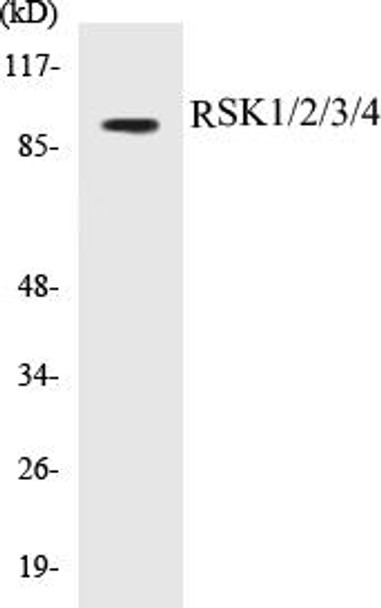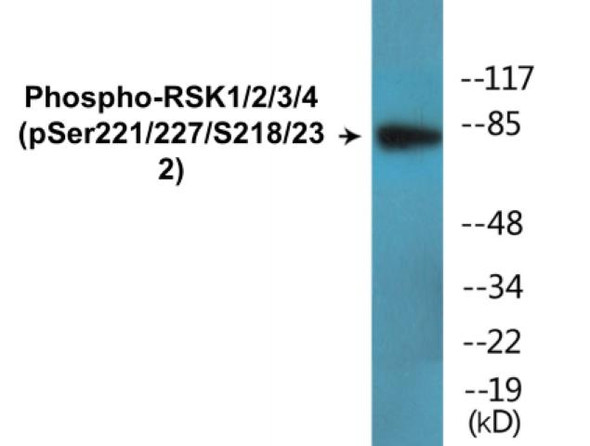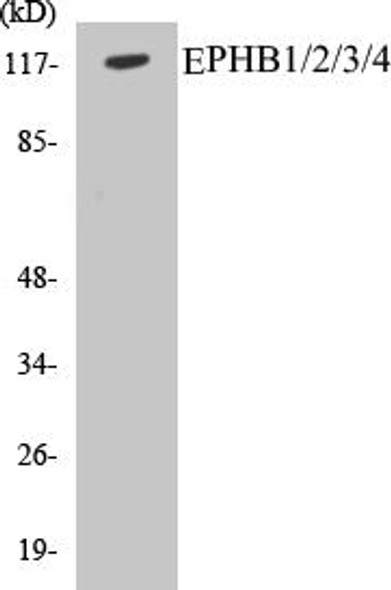Description
RSK1/2/3/4 Colorimetric Cell-Based ELISA Kit
The RSK1/2/3/4 Colorimetric Cell-Based ELISA Kit is a comprehensive and innovative tool for the detection and quantification of RSK1, RSK2, RSK3, and RSK4 levels in cell lysates. This kit offers high sensitivity and specificity, allowing for accurate and reliable results in various cell-based experiments.RSK proteins are key regulators of cell growth, proliferation, and survival, playing crucial roles in various cellular processes such as cell differentiation and transformation. Dysregulation of RSK signaling has been linked to cancer, inflammatory diseases, and neurological disorders, making them attractive targets for therapeutic intervention and biomarker development.
With this kit, researchers can easily assess the activity and expression levels of RSK1, RSK2, RSK3, and RSK4 in different cell types and conditions, providing valuable insights into their functions and potential implications in disease pathology. This versatile kit is suitable for a wide range of research applications in cell biology, pharmacology, and drug discovery.
| Product Name: | RSK1/2/3/4 Colorimetric Cell-Based ELISA Kit |
| Product Code: | CBCAB00848 |
| ELISA Type: | Cell-Based |
| Target: | RSK1/2/3/4 |
| Reactivity: | Human, Mouse |
| Dynamic Range: | > 5000 Cells |
| Detection Method: | Colorimetric 450 nmStorage/Stability:4°C/6 Months |
| Format: | 96-Well Microplate |
The RSK1/2/3/4 Colorimetric Cell-Based ELISA Kit is a convenient, lysate-free, high throughput and sensitive assay kit that can detect RSK1/2/3/4 protein expression profile in cells. The kit can be used for measuring the relative amounts of RSK1/2/3/4 in cultured cells as well as screening for the effects that various treatments, inhibitors (ie siRNA or chemicals), or activators have on RSK1/2/3/4.
Qualitative determination of RSK1/2/3/4 concentration is achieved by an indirect ELISA format. In essence, RSK1/2/3/4 is captured by RSK1/2/3/4-specific primary antibodies while the HRP-conjugated secondary antibodies bind the Fc region of the primary antibody. Through this binding, the HRP enzyme conjugated to the secondary antibody can catalyze a colorimetric reaction upon substrate addition. Due to the qualitative nature of the Cell-Based ELISA, multiple normalization methods are needed:
| 1. | A monoclonal antibody specific for human GAPDH is included to serve as an internal positive control in normalizing the target absorbance values. |
| 2. | Following the colorimetric measurement of HRP activity via substrate addition, the Crystal Violet whole-cell staining method may be used to determine cell density. After staining, the results can be analysed by normalizing the absorbance values to cell amounts, by which the plating difference can be adjusted. |
| Database Information: | Gene ID: 6195/6197/6196/27330, UniProt ID: Q15418/P51812/Q15349/Q9UK32, OMIM: 601684/300075/303600/601685/300303, Unigene: Hs.149957/Hs.445387/Hs.655277/Hs.368153 |
| Gene Symbol: | RPS6KA1 |
| Sub Type: | None |
| UniProt Protein Function: | p90RSK: an AGC kinase of the RSK family. Phosphorylated and activated by Erk1 and -2 in response to many growth factors, polypeptide hormones and neurotransmitters. Several phosphorylation sites are important for its activation. Possesses two kinase domains connected by a regulator linker region. Phosphorylates a wide range of substrates including ribosomal protein S6. Prominently expressed in brain structures essential for cognitive function and learning. |
| UniProt Protein Details: | Protein type:EC 2.7.11.1; Protein kinase, AGC; Kinase, protein; Translation; Protein kinase, Ser/Thr (non-receptor); AGC group; RSK family; RSK subfamily Chromosomal Location of Human Ortholog: 1p Cellular Component: nucleoplasm; cytoplasm; spindle; cytosol; nucleus Molecular Function:protein serine/threonine kinase activity; protein binding; caspase inhibitor activity; protein serine/threonine/tyrosine kinase activity; magnesium ion binding; ATP binding Biological Process: regulation of transcription in response to stress; axon guidance; nerve growth factor receptor signaling pathway; MyD88-independent toll-like receptor signaling pathway; stress-activated MAPK cascade; regulation of translation in response to stress; toll-like receptor 3 signaling pathway; negative regulation of caspase activity; cell cycle; signal transduction; protein amino acid phosphorylation; positive regulation of cell growth; toll-like receptor 10 signaling pathway; toll-like receptor 2 signaling pathway; toll-like receptor 5 signaling pathway; MyD88-dependent toll-like receptor signaling pathway; synaptic transmission; toll-like receptor signaling pathway; innate immune response; positive regulation of transcription from RNA polymerase II promoter; toll-like receptor 9 signaling pathway; positive regulation of cell differentiation; toll-like receptor 4 signaling pathway; negative regulation of apoptosis |
| NCBI Summary: | This gene encodes a member of the RSK (ribosomal S6 kinase) family of serine/threonine kinases. This kinase contains 2 nonidentical kinase catalytic domains and phosphorylates various substrates, including members of the mitogen-activated kinase (MAPK) signalling pathway. The activity of this protein has been implicated in controlling cell growth and differentiation. Alternate transcriptional splice variants, encoding different isoforms, have been characterized. [provided by RefSeq, Jul 2008] |
| UniProt Code: | Q15418 |
| NCBI GenInfo Identifier: | 20178306 |
| NCBI Gene ID: | 6195 |
| NCBI Accession: | Q15418.2 |
| UniProt Secondary Accession: | Q15418,Q5SVM5, Q5SVM8, Q5SVM9, Q96C05, Q9BQK2, A6NGG4 A8K9K7, B2RDY8, B7Z5J0, |
| UniProt Related Accession: | Q15418 |
| Molecular Weight: | 72,698 Da |
| NCBI Full Name: | Ribosomal protein S6 kinase alpha-1 |
| NCBI Synonym Full Names: | ribosomal protein S6 kinase, 90kDa, polypeptide 1 |
| NCBI Official Symbol: | RPS6KA1 |
| NCBI Official Synonym Symbols: | RSK; HU-1; RSK1; p90Rsk; MAPKAPK1A |
| NCBI Protein Information: | ribosomal protein S6 kinase alpha-1; 90 kDa ribosomal protein S6 kinase 1; MAP kinase-activated protein kinase 1a; MAPK-activated protein kinase 1a; MAPKAP kinase 1a; MAPKAPK-1a; RSK-1; S6K-alpha 1; S6K-alpha-1; dJ590P13.1 (ribosomal protein S6 kinase, 90kD, polypeptide 1); p90-RSK 1; p90RSK1; p90S6K; ribosomal S6 kinase 1; ribosomal protein S6 kinase alpha 1 |
| UniProt Protein Name: | Ribosomal protein S6 kinase alpha-1 |
| UniProt Synonym Protein Names: | 90 kDa ribosomal protein S6 kinase 1; p90-RSK 1; p90RSK1; p90S6K; MAP kinase-activated protein kinase 1a; MAPK-activated protein kinase 1a; MAPKAP kinase 1a; MAPKAPK-1a; Ribosomal S6 kinase 1; RSK-1 |
| Protein Family: | Ribosomal protein S6 kinase |
| UniProt Gene Name: | RPS6KA1 |
| UniProt Entry Name: | KS6A1_HUMAN |
| Component | Quantity |
| 96-Well Cell Culture Clear-Bottom Microplate | 2 plates |
| 10X TBS | 24 mL |
| Quenching Buffer | 24 mL |
| Blocking Buffer | 50 mL |
| 15X Wash Buffer | 50 mL |
| Primary Antibody Diluent | 12 mL |
| 100x Anti-Phospho Target Antibody | 60 µL |
| 100x Anti-Target Antibody | 60 µL |
| Anti-GAPDH Antibody | 60 µL |
| HRP-Conjugated Anti-Rabbit IgG Antibody | 12 mL |
| HRP-Conjugated Anti-Mouse IgG Antibody | 12 mL |
| SDS Solution | 12 mL |
| Stop Solution | 24 mL |
| Ready-to-Use Substrate | 12 mL |
| Crystal Violet Solution | 12 mL |
| Adhesive Plate Seals | 2 seals |
The following materials and/or equipment are NOT provided in this kit but are necessary to successfully conduct the experiment:
- Microplate reader able to measure absorbance at 450 nm and/or 595 nm for Crystal Violet Cell Staining (Optional)
- Micropipettes with capability of measuring volumes ranging from 1 µL to 1 ml
- 37% formaldehyde (Sigma Cat# F-8775) or formaldehyde from other sources
- Squirt bottle, manifold dispenser, multichannel pipette reservoir or automated microplate washer
- Graph paper or computer software capable of generating or displaying logarithmic functions
- Absorbent papers or vacuum aspirator
- Test tubes or microfuge tubes capable of storing ≥1 ml
- Poly-L-Lysine (Sigma Cat# P4832 for suspension cells)
- Orbital shaker (optional)
- Deionized or sterile water
*Note: Protocols are specific to each batch/lot. For the correct instructions please follow the protocol included in your kit.
| Step | Procedure |
| 1. | Seed 200 µL of 20,000 adherent cells in culture medium in each well of a 96-well plate. The plates included in the kit are sterile and treated for cell culture. For suspension cells and loosely attached cells, coat the plates with 100 µL of 10 µg/ml Poly-L-Lysine (not included) to each well of a 96-well plate for 30 minutes at 37°C prior to adding cells. |
| 2. | Incubate the cells for overnight at 37°C, 5% CO2. |
| 3. | Treat the cells as desired. |
| 4. | Remove the cell culture medium and rinse with 200 µL of 1x TBS, twice. |
| 5. | Fix the cells by incubating with 100 µL of Fixing Solution for 20 minutes at room temperature. The 4% formaldehyde is used for adherent cells and 8% formaldehyde is used for suspension cells and loosely attached cells. |
| 6. | Remove the Fixing Solution and wash the plate 3 times with 200 µL 1x Wash Buffer for five minutes each time with gentle shaking on the orbital shaker. The plate can be stored at 4°C for a week. |
| 7. | Add 100 µL of Quenching Buffer and incubate for 20 minutes at room temperature. |
| 8. | Wash the plate 3 times with 1x Wash Buffer for 5 minutes each time. |
| 9. | Add 200 µL of Blocking Buffer and incubate for 1 hour at room temperature. |
| 10. | Wash 3 times with 200 µL of 1x Wash Buffer for 5 minutes each time. |
| 11. | Add 50 µL of 1x primary antibodies (Anti-RSK1/2/3/4 Antibody and/or Anti-GAPDH Antibody) to the corresponding wells, cover with Parafilm and incubate for 16 hours (overnight) at 4°C. If the target expression is known to be high, incubate for 2 hours at room temperature. |
| 12. | Wash 3 times with 200 µL of 1x Wash Buffer for 5 minutes each time. |
| 13. | Add 50 µL of 1x secondary antibodies (HRP-Conjugated AntiRabbit IgG Antibody or HRP-Conjugated Anti-Mouse IgG Antibody) to corresponding wells and incubate for 1.5 hours at room temperature. |
| 14. | Wash 3 times with 200 µL of 1x Wash Buffer for 5 minutes each time. |
| 15. | Add 50 µL of Ready-to-Use Substrate to each well and incubate for 30 minutes at room temperature in the dark. |
| 16. | Add 50 µL of Stop Solution to each well and read OD at 450 nm immediately using the microplate reader. |
(Additional Crystal Violet staining may be performed if desired – details of this may be found in the kit technical manual.)






